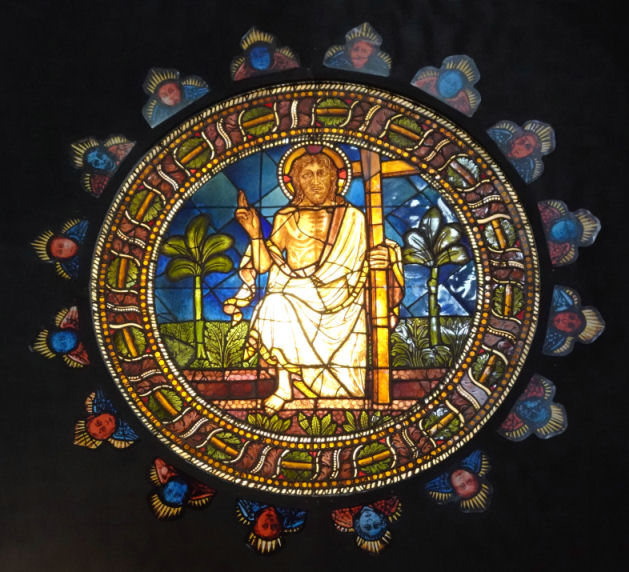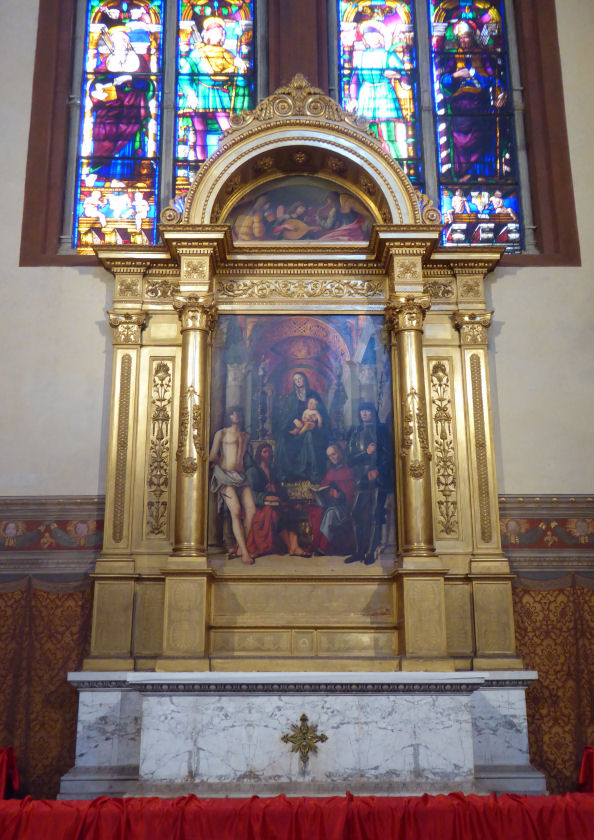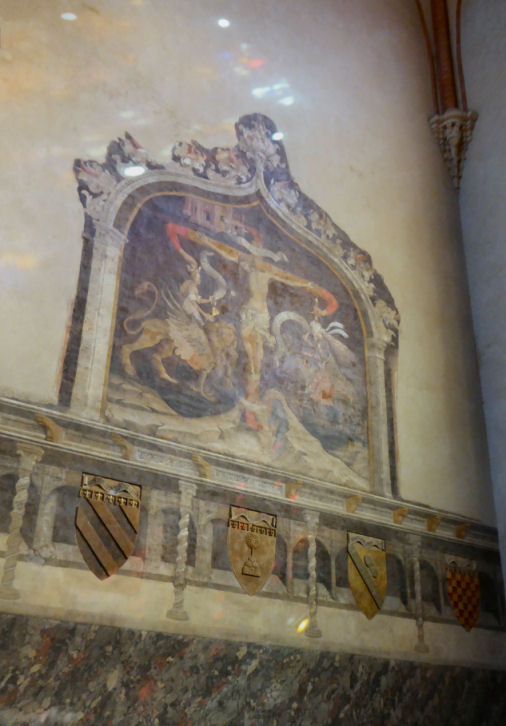| San Petronio | ||
|
History Many buildings were demolished to build San Petronio, including eight churches, following the decision to build the the church from scratch, made on October 28 1388. It is not Bologna’s cathedral but was built to be its civic/religious heart and is the 5th-largest church in Italy. It was begun, when the first stone was laid, on June 7th 1390 to designs by Antonio di Vincenzo, a local builder-architect favoured by the commune who, with the help of the friar Andrea Manfredi from Faenza, oversaw the construction until his death in 1401, by which time only four chapels were completed. Friar Andrea had also helped design Santa Maria dei Servi the church of the order he ran. Following the passing of Bologna from the commune into the hands of the Bentivoglio family, and back to papal rule in1506, work was slow and sporadic and continued until 1663, when the nave vault was finally completed, but the church's apse was still not fully completed and it lacked a transept. The church is dedicated to Bologna's patron saint, Petronius, who was bishop of Bologna from 431–50 and was buried in Santo Stefano. His remains were discovered there in 1141, but were later, in 2000, transferred here, as this church already had his head. An important historical event which took place here was the coronation of Charles V as Holy Roman Emperor by the Medici Pope Clement VII on 24th February 1530 (see the ceiling painting by Girolamo Genga below right, painted 1530-32 for Villa Imperiale, Pesaro). It took place here as a politically neutral venue after the Sack of Rome by Charles's army, and because Rome was in no fit state, being full of corpses, disease and ruins. The Pope's complete capitulation after the Sack saw the end of the Guelph/Ghibelline conflict which had begun, arguably, with the fall of the Roman Empire, and began Italy's centuries of rule by foreign powers, which only ended with the Risorgimento. Also sessions IX and X of the Council of Trent in 1547 were moved here to avoid the plague then raging in Trent. Façade Only the lower part of the brick façade was ever finished, with Istrian stone and red Verona marble decoration begun in 1538. The central portal (the Porta Magna) has sculptures by Jacopo della Quercia, begun in 1425 and considered among his best work, although left unfinished on his death in 1438. The ten large bas-reliefs flanking the door tell the story of Genesis, with the smaller inner pilasters decorated with half-figures of prophets. The lintel has five reliefs of the childhood of Christ and in the lunette are the Virgin and Child with Saint Petronius, who holds a model of the church, also by Jacopo. The Saint Ambrose on her other side was added in 1510. The two flanking portals date from 1518–30, with bas-reliefs on the pilasters by Amico Aspertini, Nicolò Tribolo, Alfonso Lombardi and others. The lunette in the left one is the Risen Christ with Soldiers by Lombardi. The Deposition in the lunette of the doorway on the right is by Aspertini, flanked by the Virgin and Saint John the Evangelist. Interior A characteristic Bolognese brick-vaulting-and-white-plaster nave, with circular windows at clerestory level and above the aisles' paired chapels. Because of the church's north/south orientation light floods in from the west windows. The nave is separated from the aisles by ten massive compound piers. The Gothic vaulting dates from 1648 and is the work of Girolamo Rainaldi, who adapted the 16th-century designs of the local architect Francesco Morandi (Terribilia). The twenty-two side chapels are all closed by screens of marble, dating from the late 15th century, or of wrought iron. The pair of 12th/13th century crosses are what remains of the four supposedly used by Saint Petronius himself to protect and mark the limits of the city in the 4th century, and were moved here in 1798. The chapels have lights which take 20 cent pieces. South (right) aisle The 2nd chapel, of St. Bridget (formerly of the Pepoli) has a gold-ground Virgin and Child with Saints polyptych by Tommaso Garelli from 1477, and early-15th-century frescoes on each side. In the 3rd chapel, of St. Ambrose (formerly of the Marsili) there is, we are told, a frescoed polyptych by the school of the Vivarini.  The 3rd and 4th were closed for restoration work in May 2024, as they had been on my previous visit in October 2019. The stained glass in the 4th chapel, the Capella della Santa Croce (formerly of the Notai) (in restauro behind scaffolding since at least 2017) was made by Michele di Matteo and the Dominican friar Jacob Griesinger (known as Giacomo di Ulm) in 1466. The chapel has boards detailing the work, with the finished top roundel of The Resurrection (see right) as the centre piece and looking fine. Jacob died in Bologna and is buried in his church of San Domenico. In the 5th chapel, of Saint Laurence (formerly of the Garganelli, Ratta and Pallotti families) is a dark Pietà with Saints Mark, Augustine, John the Evangelist and Anthony Abbot of 1519 by Amico Aspertini and some nice but worn frescoed wall decoration. In the 6th chapel, of Saint Jerome (formerly of the Castelli) (helpfully open) is Lorenzo Costa’s architectural Enthroned Saint Jerome of 1484. Its monumental frame has six built-in compartments containing reliquaries containing relics of Saint Jerome. I've recently seen the name Bernardino Orsi attached to this panel too. In the 8th chapel, of the Blessed Sacrament (formerly of the Malvezzi Campeggi) are intarsia work stalls by the Olivetan monk Fra’ Raffaele da Brescia (1521) with nine panels each side of still lifes and architecture. The 9th chapel of St. Anthony of Padua (formerly of the Saraceni and Cospi families) has a statue of Saint Anthony of Padua over the altar and monochrome frescoes of the saint’s life, all by Girolamo da Treviso and dating from 1525. There are also large frescoed panels here, higher up on the side walls and trompe l'oeil ones in the vault. The design of the stained glass here is attributed to Pellegrino Tibaldi. The very stout screen of iron bars is topped by busts of blindfolded figures. The marble screen (c. 1460) of the 10th chapel (formerly of the Society of Beccari) is fine and the work of Francesco di Simone. The 11th chapel (formerly of Zambeccari family) has a very good framed high relief on the left wall of the Assumption, by Nicolò Tribolo. The altar is piled high with reliquaries with six shelves of them behind, forming the altarpiece, and also in cases left and right. On the right wall is a tall Annunciation by Brusasorci from c.1560, with high-relief carved angels either side, reportedly the work of Properzia de' Rossi. Opposite this chapel, below left of the organ (one of the two in this church) is a striking early-16th-century polychrome terracotta Lamentation group by Vincenzo Onofri. The presbytery has intaglio choir stalls by Agostino de' Marchi, working from 1467-79 and the marble-columned tribune by Vignola from 1548. The apse-end fresco is The Virgin and Child with Saint Petronius by Marcantonio Franceschini from 1672. Crossing the church to the east end and the North (left) aisle At the end is the entrance to the museum which, in two small rooms, has façade drawings, models, vestments, reliquaries and choir books, including one with miniatures by Taddeo Crivelli. In here you will also find, from her commission to create three sibyls, two angels, and a pair of bas-relief panels, as reported by Vasari, Properzia de' Rossi's masterful panel depicting Joseph and Potiphar's Wife from 1525/6, for some reason never mounted on the façade. Vasari wrote that the sculptress was paid 'a most beggarly price for her work', blaming the painter Amico Aspertini, envious of her talent, for working against her. Vasari is also the source of the unlikely story that the panel was inspired by De' Rossi's unrequited lust for a young man, the sculpture soothing her passion. And his description of her as virtuous seems a little wide of the mark too, as her criminal records, discovered in the 19th century, show her to have been accused of assault and the destruction of vines and and a tree. Either side of the door to the museum are two doors painted by said Amico Aspertini in 1531 for the organ now in the sanctuary. They illustrate The Life of Saint Petronius and are not in the best condition.  The
10th chapel, the chapel of Saint Rosalie (formerly of the Sixteen of the
Senate, now The
10th chapel, the chapel of Saint Rosalie (formerly of the Sixteen of the
Senate, now of the city of Bologna) has The Glory of Saint Barbara by Tiarini. The 9th chapel of Saint Michael (formerly of the Barbazzi and Manzoli families) has The Archangel Michael defeating the Fallen Angels by Donato Creti of 1582. The winningly empty 8th chapel, of Saint Roch (of the Ranuzzi family) has a very Mannerist painting of a prancing Saint Roch (with the donor) by Parmigianino (1527). It's the only altarpiece by Parmigiano still in its original location, but it was in restauro in October 2019. The 7th chapel, of Saint James (formerly of the Rossi and Bacciocchi families) has a particularly fine marble screen attributed to Pagno di Lapo, and a lovely altarpiece (see photo right) of the Virgin and Child with Saints Sebastian, James, Jerome and George signed and dated 1492 by Lorenzo Costa, one of his best and most Bellini-inspired. The design of the stained glass in this chapel is also attributed to Costa. The neoclassical funerary monument on the right (1845) is for Elisa Bonaparte, Napoleon I’s sister who became Grand Duchess of Tuscany, and her husband Prince Felix Baciocchi, and is by Cincinnato Baruzzi. The 6th chapel, of Saint Vincent Ferrer (of the Griffoni and Cospi-Ranuzzi families) has a cutesy Assumption altarpiece by Scarsellino (c. 1600), who worked with the Carracci. Update May 2024 This chapel now features a display board explaining about the long-gone Griffoni Altarpiece, covering over the chapel's actual altarpiece. The casts of Jacopo della Quercia's panels from around the main portal which used to be in here are now in the last chapel on this side. The strange and huge wooden pulpit in the aisle here was built in the 15th century. The 5th chapel, of Saint Sebastian, (of the Vaselli family) (now appreciable from a platform as you enter, to protect the majolica floor) (see above right) preserves all its decoration intact from 1487–97 commissioned by Canon Donato Vaselli. The lovely huge altarpiece of the Martyrdom of Saint Sebastian is by an unknown artist of the late 15th century. It is flanked by the Annunciate Angel by Francesco Francia and the Annunciate Virgin is by Lorenzo Costa, who also painted the Twelve Apostles around the walls. The carved and inlaid wooden stalls are by Giacomo di Agostino de'Marchi from 1495 and the majolica floor - there are 1079 tiles - is the work of Pietro Andrea da Faenza and dated 1487. The 4th is the highlight Chapel of the Magi (of the Bolognini), one of the first chapels to be built, it lies behind the sunbeam in the interior photo (above right). Famous frescoes cover the three walls, dating from 1412–20 (restored in 2013) which are the best, and best-known, work of Giovanni da Modena, whose work is unknown outside Bologna. The frescoes were commissioned by a silk merchant called Bartolomeo Bolognini in his will of 1408, in which he stipulated its execution "by a good painter" using "good blue". He had been a member of the advisory board at San Petronio and an advisor to cardinal legate Baldassare Cossa, who became the schismatic antipope John XXIII. Bolognini's tomb is here, in the middle of the pavement. The chapel is dedicated to the Three Magi and on the right wall are eight scenes, some of them unusual - Bolognini's commission didn't specify the exact scenes. Reading top to bottom, right to left, they are 1 The start of the journey, 2 See the star, 3 Follow the star, 4 Meet Herod, 5 Herod with his councillors, 6 Leave Jerusalem, 7 Reach the stable, 8 Return home by sea. On the opposite wall is a huge Last Judgement. The hell scene, inspired by Dante, is dominated by a fearsome dark devil (with no willy) consuming the damned from both ends. Sinners are all around and all is chaos, although the sinners are grouped by sin. The presence of a helpfully-labelled Muhammad in the fresco, chained to a rock and tormented by a demon, has angered Islamists - plots to blow up the church were thwarted in 2002 and 2006, and there are now always armed soldiers at the entrances to the church. Ranged in the brighter panel above are the Saved, Saints and Virgins, sitting in diagonal pews below Christ crowning the Virgin, in a mandorla, whilst Saint Michael judges, in a triangle in the centre. On the altar wall are eight scenes of the Life and Miracles of Saint Petronius, reading top to bottom and left to right. The stained glass windows here depict the Twelve Apostles (with Judas replaced by Saint Paul and the four bottom left figures not identified) and are to designs by Jacopo di Paolo, who was working in Bologna between 1378 and 1426. He also polychromed the gothic carved polyptych here, which is by an unknown artist named for this work the Master of San Petronio. It shows the Coronation of the V  irgin with many saints, seventeen
figures in all. The
painted predella, also by Jacopo di Paolo, has eight scenes again showing
The
Magi's Journey to Bethlehem. irgin with many saints, seventeen
figures in all. The
painted predella, also by Jacopo di Paolo, has eight scenes again showing
The
Magi's Journey to Bethlehem.The 2nd chapel contains the head of Saint Petronius and features overwhelmingly Baroque decorative work by the Bolognese architect Alfonso Torreggiani (c. 1750) with a fine grille and the tomb of Benedict XIV. Giovanni da Modena probably also painted the Virgin in the vault here while he was at work in the first chapel. In the 1st chapel, of Saint Abbondio, (formerly of the Dieci di Balia) the framed allegorical frescoes oddly show the theological issues of Redemption and Sacrifice on the right and the Triumph of the Church over the Synagogue, to the left, in which the arms of the Cross have hands (see photo left). In this chapel Emperor Charles V's coronation by Pope Clement VII took place on 24th February 1530, as detailed in History above. Above the right door on the inner façade are Adam and Eve, attributed to the Ferrarese sculptor Alfonso Lombardi. Lost art The predella from the Cospi polyptych by Simone dei Crocefissi, from c.1396/98, showing Seven Scenes from the Life of the Virgin, is in the Pinacoteca. The Griffoni Polyptych (see reconstruction right) was painted (1470-73) for the Griffoni family chapel, the sixth on the left, dedicated to Saint Vincent Ferrer, who is depicted in the central panel of the altarpiece. It was commissioned by spice merchant Floriano Griffoni from Francesco del Cossa, with the help of the young Ercole de' Roberti, who painted the saints in the pilaster panels and the long predella. This work is contemporary with the two artists' work on the walls of the Palazzo Schifanoia in Ferrara. Local woodworker Agostino de' Marchi was entrusted with the polyptych's woodwork. The altarpiece features a portrait of Floriano in the guise of his name saint, top left and his wife Lucia as her name saint top right. The altarpiece was dismembered and sold between 1725 and 1731, after the chapel passed to the Aldrovandi family in 1725, and was renovated. There are 14 surviving panels. The main panels are split between the National Gallery in Washington (the Crucifixion roundel and the flanking Saints Florian and Lucy), The Brera in Milan (Saints Peter and John the Baptist), and the National Gallery in London (Saint Vincent Ferrer). Of the five remaining small full-length saints from the pilasters, all by Ercole, Saint Petronius is in the Ferrara Pinacoteca Nazionale, Saints Michael and Apollonia are in the Louvre, Saint Anthony Abbot is in Rotterdam, and Saint George is in the Palazzo Cini Gallery in Venice. (Saints Jerome and Catherine of Alexandria, also in the Cini and previously though to be from this altarpiece have now been ruled out, being too big.) The predella, depicting The Miracles of Saint Vincent Ferrer, is in the Vatican, and the small round Annunciation panels are in Gazzada. Following the events recounted in History above Michelangelo was commissioned by Pope Julius II to make an eleven-foot high commemorative bronze statue of himself. The foundry Michelangelo used was in Piazza Galvani, behind San Petronio, and is today marked by a plaque. This is also where Giambologna cast his statue for Bologna’s famous Fountain of Neptune. Julius's statue was placed over the main door here in 1508 but destroyed three years later by Annibale Bentivoglio, briefly Lord of Bologna, following the statue's toppling during riotous celebrations of the Bolognese defeat of Julius's forces. The pieces where sold to the Alfonso I, Duke of Ferrara, Annibale's brother-in-law, who used them to cast a cannon, named La Giulia. But he kept the head. Campanile Built by Pietro da Brensa in 1492 Opening times Daily 9.30 – 1.00 & 2.30 – 6.00 Capella Bolognini: €5 entry fee Update May 2024 The price of entry to the Bolognini Chapel now includes entry to the two chapels to its right, dedicated to Saint Sebastian and Saint Vincent Ferrer, the latter being the former site of the Griffoni Polyptych. The ninth and tenth chapels on the left side have the restorers in. |
|
|
|
|